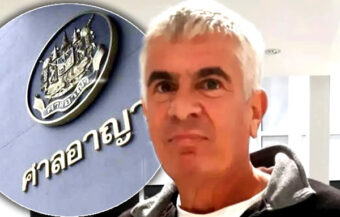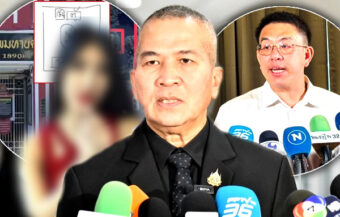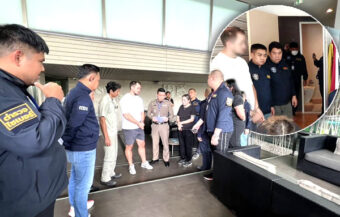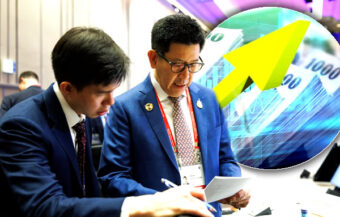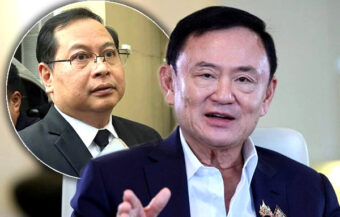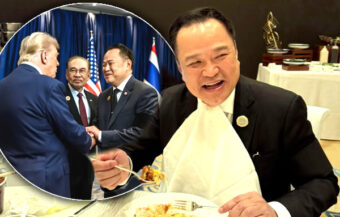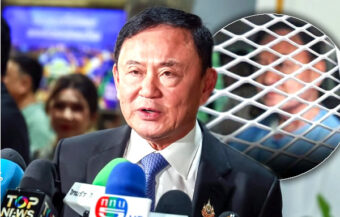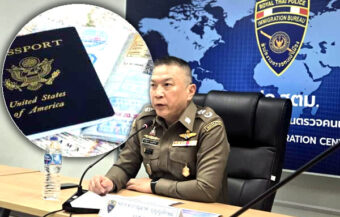Thaksin joins urgent talks at Phitsanulok Mansion as Thailand faces a crushing 36% US tariff. With China’s warnings and US pressure mounting, the country races against time to protect exports and avoid economic disaster in a high-stakes trade showdown.
Former Prime Minister Thaksin Shinawatra returned to the heart of power on Friday, stepping into urgent talks at Phitsanulok Mansion — the Prime Minister’s official residence — as Thailand scrambles to head off a brutal 36% U.S. tariff announced Tuesday. Thaksin, no stranger to high-stakes diplomacy, joined the government’s negotiating team at dawn. With ties to both U.S. President Donald Trump and Beijing’s inner circle, his presence signals the crisis is escalating fast. On Wednesday, Thaksin confirmed that Thai negotiators are under pressure from China. Beijing, he suggested, warned against swinging too far toward Washington.
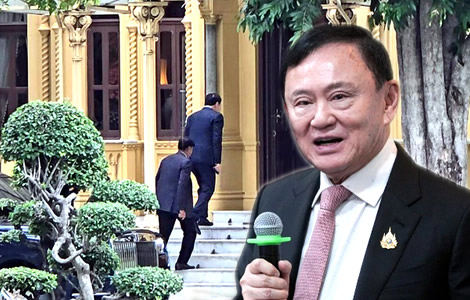
Thaksin didn’t mince words. Giving in to U.S. demands, he said, could bring serious consequences. “If we rush and give in to everything — stripping ourselves naked — we’d get exploited,” he warned.
Then came the hammer blow: “If granting them everything brings war to our soil, then no — we won’t do it.”
Thailand is now caught between two superpowers. With the clock ticking and pressure mounting, the outcome of these talks could reshape the region’s trade landscape — or spark an ongoing economic malaise for Thailand.
Thaksin joins emergency tariff talks as government scrambles to prevent devastating new US tax
Former Prime Minister Thaksin Shinawatra returned on Friday. He arrived at Phitsanulok Mansion at 7:47 a.m. He joined ministers and advisors in urgent talks. They prepared for a US tariff threat. This threat involves a proposed 36% import tax. It targets Thai exports to the United States.
Thaksin remains a powerful figure. Notably, he has close ties to US business leaders. Moreover, he is a personal friend of former US President Trump. Also, he understands China’s pervasive regional influence. Thus, his presence adds political weight to the negotiations.
The government is racing to finalise its offer. Indeed, officials are working before the August 31 deadline. This deadline was set by President Trump. However, time is running short. Furthermore, the 36% tariff could devastate Thai exporters.
Thailand depends heavily on US demand. In 2024, the US took 18% of Thai exports. Consequently, economists are sounding the alarm. Meanwhile, shipments surged 15% in early 2025. This surge occurred before the tariff announcement. However, long-term stability is uncertain.
Thai negotiators face intense pressure as US and China compete for leverage in regional trade influence
Government sources say Thailand is caught in a power struggle. Indeed, the US and China are pushing simultaneously. According to anonymous finance officials, China opposes equal trade access to Thailand for the United States. Consequently, Thai negotiators are stuck. Moreover, officials admit Chinese pressure has caused indecision.
On Wednesday, Thaksin confirmed that pressure. He also warned against following US demands blindly. “If we rush and give in to everything — stripping ourselves naked — we’d get exploited,” he said. Furthermore, he cautioned that concessions could lead to conflict. “If granting them everything brings war to our soil, then no — we won’t do it.”
On Thursday night, finance ministry sources briefed the press. They said Beijing is adamant against parity with the US under ASEAN deals. As a result, Thai officials are divided. Meanwhile, negotiators must balance US and Chinese interests. They also must protect farmers and small businesses.
Finance Minister Pichai Chunhavajira took charge. On Wednesday, he convened the JSCCIB committee. There, he assessed tariff impacts on exporters. Afterwards, Pichai said a more granular approach is underway. Specifically, the government will tailor solutions per product group. Furthermore, they will evaluate local content levels in goods.
Thailand finalises a detailed response to the US as private sector impact data pours in ahead of deadline
Additionally, private sector groups are submitting impact data. Indeed, they must send reports by Friday. Also, Pichai chaired another meeting on Friday. That meeting included ministers, advisors, and Thaksin. It aimed to refine Thailand’s response proposal.
Thailand’s offer reportedly targets 90% of US goods. Thus, it includes tariff removal on most imports. Additionally, officials propose eliminating non-tariff barriers. They also plan to reduce Thailand’s trade surplus by 70%. This would occur over five years. Moreover, they will promote investment and bilateral trade.
However, Thailand still faces risks. China remains wary of closer US ties. Indeed, officials said Beijing’s warning slowed progress. That tension complicates drafting a final offer. Nevertheless, government leaders hope to secure compromises from both sides.
Meanwhile, Poj Aramwattananont, chairman of Thailand’s Chamber of Commerce, spoke out. He said impacts vary by product type. Indeed, items with low local content will suffer most. Moreover, he noted uncertainty over US demand for high local content. He also urged Thailand to push for a lower tariff rate than Vietnam.
Thailand’s trade surplus with the US stands at $40 billion. By contrast, Vietnam’s is about $120 billion. Thus, Thailand should have a negotiating advantage.
With Thaksin advising behind the scenes, Thai leadership braces for fallout if talks with US fail
At this time, suspended Prime Minister Paetongtarn Shinawatra remains out of office. Therefore, Deputy Prime Minister Phumtham Wechayachai now leads. Meanwhile, Thaksin returned from exile in 2023. Since then, he has shaped economic strategy. Furthermore, he influenced crisis management during this tariff threat.
In recent months, Thaksin has sounded repeated warnings. He said Thailand must avoid being a pawn between superpowers. Also, he emphasised protecting farmers and small businesses. Consequently, his guidance may shape the final deal.
If negotiations fail, the 36% tariff may hit. That would harm exporters and producers alike. However, officials remain optimistic. Indeed, they hope US officials will accept Thailand’s concessions.
In the meantime, Thai leaders prepare for possible direct talks. Finance Minister Pichai said he will travel to Washington if needed. Meanwhile, Thailand’s negotiating team waits for formal responses. In the meantime, they continue drafting fallback measures for producers.
Race against time as Thailand walks a tightrope between Chinese warnings and US economic retaliation
Overall, Thailand is racing. It must respond to US pressure without offending China. With Thaksin back in the room, the government is more focused. Yet, significant challenges lie ahead. The next weeks will determine whether the 36% threat can be averted.
That tariff at nearly double the 20% rate for Vietnam threatens not only Thailand’s lucrative export trade to the United States, but will certainly see investment not only failing to come to Thailand, but being diverted away with urgency.
Thailand still in denial about the gravity of its position as the US effectively downgrades it economically
Thaksin stoutly defends Prime Minister Ung Ing and blames the 2017 Constitution for thwarting progress
Vietnam becomes the US partner of choice while Thailand is gutted with a 36% tariff and is left the big loser
In short, factories already located in Thailand are quite likely to move to Vietnam if the tariff difference is confirmed.
In economic terms, it is a damaging blow to Thailand—the equivalent of a nuclear bomb being dropped on the country’s export-led economy—despite efforts in Bangkok to downplay the impact of the crisis.


